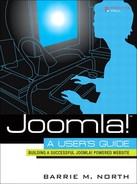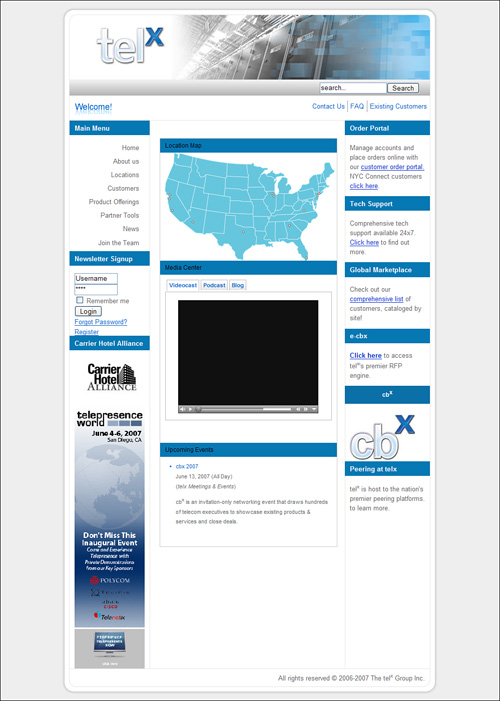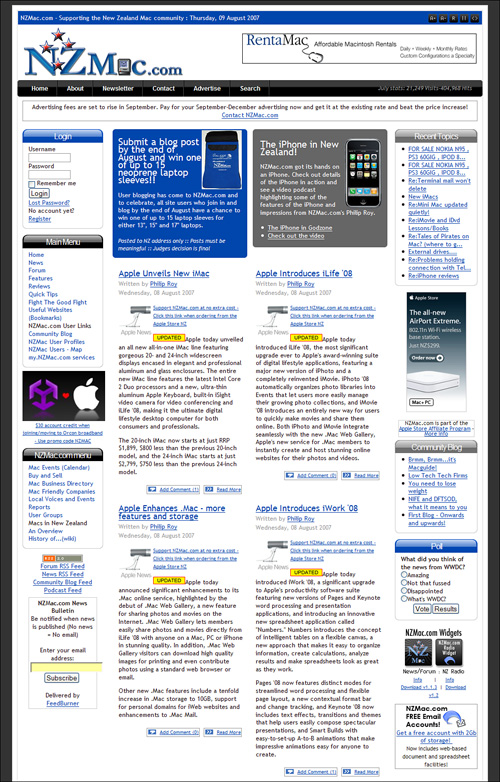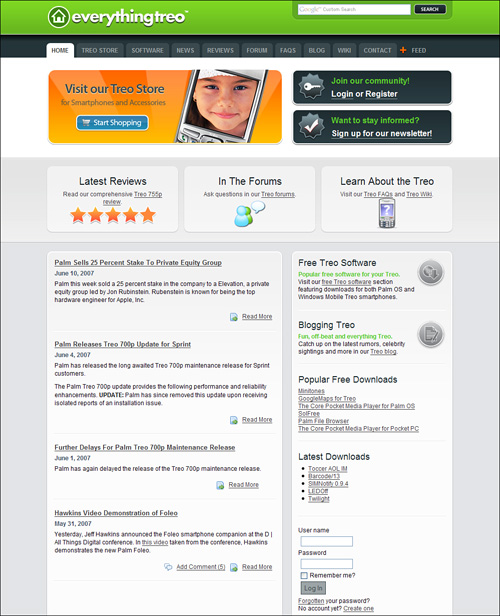Joomla powers millions of websites. One of the amazing things is the range of sites that you can find it on. This Appendix gives you some of the results from a Joomlashack survey and also six case study interviews from various types of websites.
In May 2007 Joomlashack conducted a survey of Joomla users. Over 3,600 users responded. One of the questions asked in this survey was, “What type of site do you use Joomla for?” The results are shown in Figure B.1.
Clearly, Joomla enjoys widespread use. To provide some insight into these Joomla-powered sites, six Joomlashack clients generously agreed to take part in a brief interview to offer case studies in how real organizations use Joomla. They represent (I hope) a broad sample of the spectrum of organizations and users that are using Joomla.
The six case studies include
a magazine publishing company
a medium-sized municipality in Florida
a public library in metro Detroit
an interconnectivity service company
a community/news site about Macs
a community site about smartphones
www.yourwedding.com.au (MP Media)
Welcome to Your Wedding (www.yourwedding.com.au) helps brides in Australia find resources they need (see Figure B.2) and is a companion site to their offline magazine publication. It combines many resources, such as directories, a blog, shopping, a planner, and forum, all tied together with Joomla. It also serves as the online presence for its offline magazines.
www.longwoodfl.org (City of Longwood, Florida)
The City of Longwood is a medium-sized municipality in Florida. Seeking to update an old site, it carefully examined various CMS options including open source alternatives. Figure B.3 shows the site.
www.ropl.org (Royal Oak Public Library—Michigan)
The public library in Royal Oak, Michigan, has a great website for the community, shown in Figure B.4. It includes many interactive features made possible with Joomla.
Briefly describe your organization. | |
Royal Oak Public Library (www.ropl.org) is a public library in metro Detroit serving 60,000 residents. We have about 112,500 books and audio-visual materials in our collection. We provide 36 computers for public use. We receive about 1200 hits to our website every day. | |
Briefly describe the goals of your web presence. | |
Our goal for our web presence is to convey current and updated information about programs and events at our library, book reviews and recommendations, a portal for research databases and a seamless transition to our collection catalog. | |
Briefly describe the status of your web presence prior to using Joomla. | |
Prior to using Joomla, our website was comprised of basic HTML and tables and nearly every page had a different look and feel to it. This included the layout, color scheme, and font attributes. One person was designated to add content. | |
Why did you use Joomla to create your site? | |
We decided to use Joomla because we were fascinated with the flexibility, usability, third-party extensions, and ability to have all our staff members add content when they want. | |
What third-party extensions do you have installed? | |
Attend Events (program registration) Bookmarks (portal for research database) Extended Menu (menu structure and pathway) FacileForms (advanced forms) Fireboard (forum) JCal Pro (calendar) JCE (WYSIWYG editor) Jom Comment (allow for public comments on content) Jombackup (daily, automatic backup of Joomla database) MyContent (allows staff to add content to website without admin privileges) Opening Times (flexible display of hours of operation) | |
What parts of Joomla do you struggle with the most? Which features do you like the most? | |
We struggled with how to organize our Sections and Categories to form our navigation menus. This wasn’t due to Joomla, though. What is a limit in Joomla is the ability for staff members to add images/media to the content that they publish with the third-party extension, MyContent. Joomla requires someone with admin privileges to upload images/media to their web server before another staff member can display it in their content. | |
How has Joomla changed how your organization uses your website? Has it changed your web goals? | |
Joomla has allowed all staff members to add content in a blog format to our website easily. It has freed up our webmaster to concentrate on other performance and design issues. We now accept online registration for programs that require it, online volunteer forms and comments on content from visitors. Joomla helped us realize what our web goals should be. One week of playing with Joomla and you’ll be amazed at what you can do with it. | |
How (if it has) has Joomla made it easier to reach your web presence goals? | |
Our web goals have been met by having flexible content be displayed on our website without much management. Our programs and events are displayed and removed automatically, we can keep track of the usage of our research databases and some visitors to the website have left comments on content which opens up communication between them and our staff. |
www.telx.com (The Telx Group, Inc.)
The Telx Group’s site, shown in Figure B.5, is an excellent example of the next generation of company brochure sites that use a CMS. Joomla makes it possible to have a coherent look (the template) across the site and makes it easy to add and maintain content.
NZMac.com is a high-traffic community news site. It leverages Joomla to bring a community of Mac users together online. The site is shown in Figure B.6.
Briefly describe your organization. | |
NZMac.com is a website owned and operated by Philip Roy and dedicated to supporting the New Zealand Macintosh community. It includes the latest New Zealand Macintosh news, discussion forums, international news and reviews. NZ Mac events, businesses, user groups, and Mac items for sale are all featured on the site. | |
Briefly describe the goals of your Web presence. | |
Mac users worldwide are an enthusiastic and obsessive bunch of people. With NZMac.com, the focus is specifically on developing a sense of community within New Zealand and the Macintosh user base. Although the site is owned by Philip Roy, many facets of the site are developed through consensus and through gauging the needs of sites users. It is hoped that NZ Mac users, User Groups, companies, and institutions will take an active part in using the site and contribute to it. Through the use of discussion forums, buy/sell areas, NZ news and information with a specific New Zealand flavour, it’s hoped to provide a website that Mac users in New Zealand will look to as their main source of all things Macintosh. | |
Briefly describe the status of your Web presence prior to using Joomla. | |
With the exception of the discussion forum (which has always been a database-driven form system) NZMac.com began its life as HTML pages (see http://www.nzmac.com/previous_site_designs.html), managed using Dreamweaver. RSS feeds of news from overseas sites lessened the amount of work required to update the site at the time, but more was needed. | |
Why did you use Joomla to create your site? | |
I explored a number of CMS systems and had used Xoops for some time. The decision to move to Mambo (and then Joomla) was for a variety of reasons:
| |
What third-party extensions do you have installed? | |
Components Bookmarks component (www.tegdesign.ch) Community Builder (www.joomlapolis.com) eXiT-Poll (www.phpprojects.net) Google Maps (www.atlspecials.com/index.php?option=com_google_maps&Itemid=36) JA Submit (www.joomlart.com) JCal Pro (dev.anything-digital.com) JCE Editor (http://www.cellardoor.za.net/jce/) JomComment (www.azrul.com) joomlaXplorer (http://developer.joomla.org/sf/projects/joomlaxplorer) Knowledgebase (www.phil-taylor.com) mosDirectory (www.phil-taylor.com) OpenSEF (www.j-prosolution.com) OpenWiki (www.j-prosolution.com) Phil-A-Form (www.phil-taylor.com) RSS XT (www.nodetraveller.com) SMF Bridge (www.simplemachines.org) YaNC (www.joomla-addons.org) Mambots of Interest TagBot (www.fijiwebdesign.com) Modules of Interest mod_kl_evalphp—used to pull in PHP code for OpenAds advertising (www.idealagent.com) | |
What parts of Joomla do you struggle with the most? Which features do you like the most? | |
My biggest issue has been anything that isn’t directly integrated into Joomla. The best example of this is the SMF forum, which is bridged...meaning that items of information (i.e., user information) are shared but not truly combined. This has caused users a few headaches with logging in and out, so I am planning to move to the forthcoming Fireboard (www.bestofjoomla.com) forum component, as it is truly integrated. At the same time, Joomla still does not cater for true control over who accesses what or can submit items and so on, so access control and functionality has taken a long time to sort out and is still crude in many respects. I also find the concept of archived stories very confusing. I archive nothing because this seems to suggest the item is no longer accessible. | |
How has Joomla changed how your organization uses your website? Has it changed your Web goals? | |
It has just made life so much easier, made control and organizing the site so much simpler, whilst allowing new functionality to be added in and tested much more quickly. I may not be the tidiest of people, but I insist that my websites are tidy and exceptionally well structured. It has meant that developing content for Joomla has been so much quicker than traditional web creation. This means I can respond to news stories, users’ requests, and site use in a much more immediate and dynamic way, and it has allowed the site to reach out to the web community far better, through the advanced functionality and through a web presence that is far more functional and professional than I was providing previously. | |
How (if it has) has Joomla made it easier to reach your Web presence goals? | |
Through something that Joomla and NZMac.com see as vital to their existence—Community! The vibrancy, support, enthusiasm, passion, and pure talent that is out there...and the fact that these people so willingly give their time to help others is overwhelming and should never be discounted as such an important factor in why Joomla is such a superb web system. It’s not just about the fantastic software...it’s about the community around it. |
www.everythingtreo.com (Everything Treo)
Everything Treo is another example of a community site focused on technology. It is actually part of a series of sites all with a similar theme. The site is shown in Figure B.7.
Several common themes emerge about Joomla from these case studies and seem to be the hallmarks of what Joomla can offer to an organization:
Most sites were previously in separate pages of HTML. Keeping them all coherent was difficult. The common template of Joomla has allowed a common graphical design site-wide that is on autopilot. The organization can focus much more on content.
All of the sites added third-party extensions to a lesser or greater extent to achieve the functionality they needed. Almost all of them took advantage of a commercial component.
The effectiveness in adding new content to the site was greatly enhanced. Organizations were able to make updates in real time, and many found they were able to greatly expand their base of people contributing to the content of the site.
Taking advantage of some core Joomla features and third-party functionality, many of these sites have a rich interactive user experience. Being able to allow site visitors to participate in creating content is the next threshold in the development of the Web.
Clearly, Joomla has helped these organizations create a Web presence that was previously only possible for big companies and/or big budgets. Open source software such as Joomla, along with a wide availability of commercial and GPL extensions, extends this opportunity to everybody, big and small, alike.







